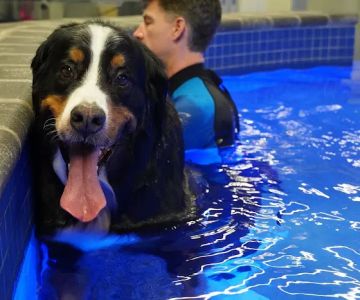How to Deal with Separation Anxiety in Dogs: Effective Solutions
As a dog owner, one of the most heartbreaking experiences is watching your dog suffer from separation anxiety. I know this firsthand with my dog, Charlie. He would become incredibly distressed whenever I left for work, howling and tearing up the furniture. I tried various methods, and over time, I found what worked best for him. If you’ve noticed signs of separation anxiety in your dog, rest assured, you’re not alone. This common issue can be effectively managed with patience, understanding, and the right strategies. In this article, I’ll share my experience and expert insights on how to help your dog overcome separation anxiety.
1. Understanding Separation Anxiety in Dogs
Before we dive into solutions, it’s important to understand what separation anxiety in dogs really is. This condition occurs when a dog becomes excessively anxious and distressed when separated from their owner or caretaker. It’s more than just disliking being left alone—it's a real emotional response that can manifest in various behaviors, such as destructive chewing, incessant barking, urinating, and defecating indoors, or even attempts to escape the house. Charlie, for instance, would destroy pillows and shoes when left alone, showing signs of extreme stress.
Separation anxiety is often triggered by changes in routine, moving to a new home, a loss of a family member, or changes in the owner’s schedule. For some dogs, it’s a deeply ingrained issue that requires time and consistent effort to manage. Understanding that this behavior stems from fear and not malice is crucial in addressing it effectively.
2. Recognizing the Signs of Separation Anxiety
Recognizing the signs of separation anxiety is the first step in finding a solution. While every dog is different, common signs include:
- Excessive barking or howling: Dogs with separation anxiety will often bark or howl incessantly when left alone.
- Destructive behavior: Chewing, scratching at doors or windows, or even trying to escape are common signs of distress.
- Urinating or defecating indoors: Even well-trained dogs may urinate or defecate in the house when they feel anxious.
- Pacing or drooling: Some dogs may pace or salivate excessively when left alone, indicating high anxiety levels.
If you notice these behaviors in your dog, it's essential to take steps to address the underlying anxiety before it gets worse.
3. Gradual Desensitization: Teaching Your Dog to Be Comfortable Alone
One of the most effective methods I used to help Charlie was gradual desensitization. This involves slowly getting your dog used to being alone in small increments, eventually helping them adjust to longer periods of separation. Here’s how I implemented this method:
- Start with short absences: Initially, I would leave Charlie alone for just a few minutes and then return. The goal was to let him know that being alone doesn’t mean something bad will happen. Over time, I gradually increased the duration of these separations.
- Use positive reinforcement: Each time I returned and Charlie was calm, I rewarded him with treats or praise. This created a positive association with being alone.
- Consistent routine: Dogs thrive on routine, so I made sure Charlie’s schedule remained consistent, with regular feeding times, walks, and potty breaks. This helped him feel secure and less anxious.
Gradual desensitization is not a quick fix, but with patience, you’ll see improvements as your dog learns that your absence is temporary and not something to fear.
4. Crate Training: Creating a Safe Space for Your Dog
Crate training was another essential part of managing Charlie’s separation anxiety. Contrary to the misconception that crates are punitive, they can actually be a calming space for your dog. Many dogs, including Charlie, view their crates as a safe retreat where they can relax and feel secure. Here’s how I incorporated crate training into our routine:
- Start slowly: I introduced Charlie to his crate gradually, allowing him to explore it at his own pace. I placed soft bedding, his favorite toys, and a treat inside to make it inviting.
- Short durations in the crate: I initially left him in the crate for short periods while I was at home. Over time, I began closing the door and leaving him in the crate for longer periods while I did chores or worked.
- Positive reinforcement: Just like with desensitization, I rewarded Charlie for being calm in the crate. This helped him associate the crate with comfort and security.
Crate training, when done correctly, can be a powerful tool in helping your dog feel safe and calm when left alone.
5. Counter-Conditioning: Changing Your Dog’s Emotional Response
In addition to desensitization and crate training, I also used counter-conditioning to change Charlie’s emotional response to being alone. Counter-conditioning involves associating being left alone with something positive, such as treats or toys. Here’s what worked for me:
- Use high-value treats: I would give Charlie a special treat or chew toy that he only received when I left the house. Over time, he began to associate my departures with something enjoyable rather than stressful.
- Interactive toys and puzzles: I made sure Charlie had engaging toys or treat-dispensing puzzles to keep him occupied while I was away. This helped divert his attention from my absence and made the experience less anxiety-inducing.
By using counter-conditioning, I was able to change Charlie’s emotional response to being left alone, making the experience less stressful for him.
6. Medication and Professional Help
In some cases, despite all efforts, separation anxiety can be severe and require professional intervention. After several months of trying desensitization and training, I decided to consult with a veterinarian, who recommended anti-anxiety medication to help Charlie manage his symptoms. Medications such as selective serotonin reuptake inhibitors (SSRIs) or other calming agents can be prescribed to help dogs cope with anxiety, especially if behavioral training alone isn’t enough.
- Consult a veterinarian: If your dog’s separation anxiety is severe and nothing seems to work, it may be time to talk to a vet. A vet can diagnose the severity of the anxiety and recommend appropriate medications.
- Professional training: In some cases, a professional dog trainer who specializes in anxiety-based behaviors may be helpful. They can create a tailored training plan for your dog.
While medications are not a long-term solution, they can help manage your dog’s anxiety while you work on behavioral training.











